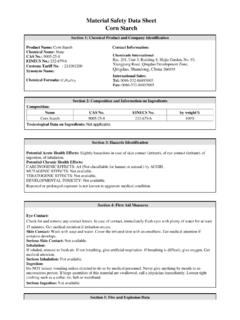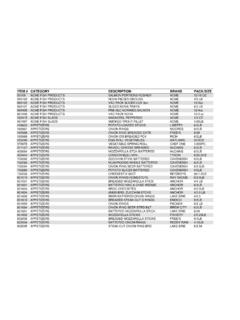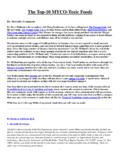Transcription of BY-PRODUCTS USED FOR FEEDING DAIRY CATTLE
1 1 BY-PRODUCTS used FOR FEEDING DAIRY CATTLE Cooperative Extension Service. The University of Georgia. College of Agriculture. Athens BY-PRODUCTS that result from the processing of food for humans have been used for many years to feed CATTLE . DAIRY CATTLE rations may be formulated from BY-PRODUCTS and roughage feedstuffs that cannot be used for human consumption. There are a variety of materials used : wheat bran, corn gluten feed, soybean meal, cottonseed meal, peanut meal, citrus pulp, beet pulp, brewers grains, molasses, hominy feed, feather meal, blood meal, meat and bone meal, fish meal, fats, corn cobs, soybean hulls, peanut skins, sunflower meal, rice bran, cottonseed hulls and many others.
2 This bulletin discusses many of the BY-PRODUCTS that may be used to formulate rations for DAIRY CATTLE . It includes their FEEDING values and restrictions in the diet. A nutrient composition table for many byproducts available in Georgia appears on page 11. OIL SEED MEALS Cottonseed, peanut, soybean, sunflower and canola meals are high protein supplements and are generally available statewide. Peanut, canola and sunflower meal may not be readily available throughout the state, but may be obtained.
3 Generally, soybean meal is the preferred source of natural protein. For lactating DAIRY cows, cottonseed, peanut and low crude fiber sunflower meal may be used to replace soybean meal. Sunflower meal that is high in crude fiber should be restricted to 20 to 25 percent of the grain mixture because of palatability. Canola meal is similar to sunflower meal in that it is high in crude fiber, which lowers the TDN value. Thus, the energy value relative to soybean meal is lower. Use caution when you feed cottonseed meal to high producing cows, especially when whole cottonseed is included in the ration.
4 Recent research indicates that during hot weather, and at high levels of cottonseed meal FEEDING the gossypol detoxification mechanism of the rumen may become overloaded. This condition allows gossypol to escape breakdown in the rumen and enter the blood stream to create gossypol toxicity and possible sudden death. Therefore, for high producing cows, restrict cottonseed meal to 35 to 40 percent of the grain mix or a maximum of 10 pounds per cow per day. If whole cottonseed is being fed, this should be added to the cottonseed meal weight to determine that not more than 10 pounds per cow per day are being consumed.
5 All of these high protein supplements are excellent sources of energy. They may be used for energy when consumed in excess of the protein requirements. WHOLE SOYBEANS AND COTTONSEED Both whole soybeans and cottonseed may be used in DAIRY rations. Restrict both to five to seven pounds per cow per day. They are excellent sources of energy and protein. Soybeans are approximately 38 percent crude protein, and cottonseed approximately 20 percent crude protein. Soybeans should be ground or cracked prior to FEEDING .
6 Roasted soybeans also serve as a good source of rumen undegradable protein, but care should be exercised so that soybeans have not been overheated, thus rendering the protein unavailable to the cow. Excellent results have been obtained by FEEDING whole cottonseed without grinding or cracking. Do not grind or crack more than a three-day supply of soybeans or cottonseed during hot weather. The oil will become rancid if exposed to air too long.
7 Whole cottonseed must be stored so that it does not pick up moisture during storage. Cottonseed must be maintained at less than 13 percent moisture to prevent mold growth. Whole cottonseed stored at moisture contents above 13 percent may grow Aspergillus Flavus, which is the mold that produces aflatoxin. Samples of moldy cottonseed have been found to contain 1000 to 3000 ppb of aflatoxin. Aflatoxin is extremely toxic to CATTLE . HIGH FIBER BY-PRODUCTS 2 SOYBEAN HULLS are an excellent source of energy and digestible crude fiber.
8 The high digestibility of the fiber and the physical form of the hulls render soybean hulls of limited value as roughage. They may contain 11 to 15 percent crude protein and are a good source of magnesium. SUNFLOWER HULLS are not readily available in Georgia. They are low in crude protein ( percent) and TDN (62 percent) and high in crude fiber (50 percent). Hulls derived from oilseed processing are higher in protein and fat than those obtained from confectionery varieties. Sunflower hulls may be fed up to 30 percent of the total ration and are considered a good roughage replacer.
9 Use caution when sunflower hulls are used at levels above 30 percent because of possible impaction or constipation. Don't feed sunflower hulls as the only source of roughage. Some long hay, silage or green chop should be included to prevent cows from going off feed. COTTONSEED HULLS are a poor source of protein and energy but may be used as a roughage replacer on a pound per pound basis. Research indicates that if no hay, silage or pasture is used , 15 to 18 pounds of cottonseed hulls must be fed to prevent rumen acidosis.
10 Even at this level, the milk fat test may become depressed. PEANUT AND RICE HULLS are worth even less than cottonseed hulls. They both are extremely low in energy and protein. Peanut and rice hulls are not good sources of roughage. They should not be used in lactating DAIRY cow rations unless no other source of roughage is available. Ground peanut hulls and rice hulls should be avoided. corn COBS are not generally available in Georgia; still, they may be used as a roughage replacer for hay and silage. They are low in crude protein and should probably be considered as zero crude protein.




